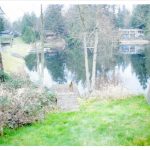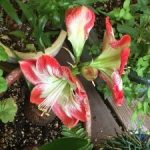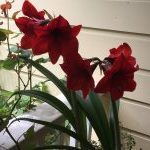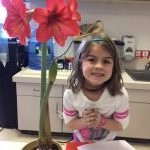 Simply Said: “THE POWER OF DIRT AS A CATALYST FOR HEALING AND HOPE”
Simply Said: “THE POWER OF DIRT AS A CATALYST FOR HEALING AND HOPE”
In 2007 my Father who lived in a more northern part of the state from where I lived, was officially diagnosed with Alzheimer’s Disease. He had been developing symptoms slowly over the 5 years prior but the ability to deny, ignore or wish away the symptoms were gone. He was 79 years old. One year later, he became ill with a bladder infection. The infection has caused him to develop a “Delirium”- a severe worsening of his confusion, which after efforts were made to treat the infection outside of the hospital setting, but he did not improve, he became suspicious and difficult to redirect.
Along with the Delirium came symptoms that made it abundantly clear that he suffered from Post- Traumatic Stress Disorder (PTSD) the result of being a Veteran of three long and brutal wars. We had all suspected it, but my father did a good job of hiding it through his natural quiet nature and a couple of good “nips” of whiskey at night. He rarely spoke of his years serving in combat, and on the rare occasion when he did make a reference to his war experiences, you could tell some of the memories were very painful for him and haunted him throughout the rest of his life.
Not to say my father was a sad, morose or brooding type of man, quite the contrary he was funny, a much- loved sort of fellow with a dry wit and warm heart. Even in the middle stages of his Dementia, he could still manage a joke or humorous observation.
The Delirium I mentioned earlier, developed shortly after he was admitted to the hospital in the community where he and my mother lived. Once the Delirium developed his decline was rapid. He died just a little over two weeks after his admission. It was hard to believe that just prior to his becoming physically sick and the hospitalization he had been operating a riding mower, looking out the window to see if he could spot deer and visiting with family. He was troubled by the Alzheimer’s back then but was functioning.
I attribute the rapid decline that led to his death in part; to the nature of the Alzheimer’s, (he was also diagnosed with Lewy Body Dementia and Vascular Dementia) his age, and his comorbid medical conditions (he developed pneumonia soon after being admitted to the hospital), but also to the experience he had in the hospital. The hospital experience was very traumatic. There were no specialized services for his specific care needs. And even with my best efforts and those of my sister, he endured a series of harsh treatments, void of any consistent quality or compassionate care.
The hospital staff were poorly equipped to handle his confusion and behaviors, he thought he was fighting the war again, he thought the enemy was coming for him, so the hospital responded to this by placing hard leather restraints on him and tying all of four of his extremities to the bed frame, he restrained like this or in some other manner for well over 70% of his time there. (I know, I reviewed his hospital record he was there about 10 days) When I traveled up north to the hospital to see him, I walked in to find him tied up, naked, with a nurse aide tucking his bottom sheet into the bottom of the mattress along with his catheter, this had to have very painful and he was quietly protesting by groaning and flinching, but the nurse aide did not seem to be aware of this.
In his confused state, he thought he was in “the brig on a navy ship.” He was never allowed to be placed in an actual patient room, where it would have been quiet, but was left in a curtained-off triage area for several days. The environment was dimly lit and noisy, along with the general noises of people talking and moving about, the staff had placed a small television directly in front of him. It was on a children’s cartoon network. I father never watched cartoons, he liked Westerns and “Walker Texas Ranger.”
After much protesting, he was eventually transferred for a brief time to a Psychiatric Hospital and then to a Nursing Home, where died the day after getting there. His death was sad and tragic.
I was devastated, I was a nurse who had spent years caring for patients with Alzheimer’s myself, yet I could not prevent or convince those in charge of his care to treat him in the manner I had come to understand and expect as “best practice” a term for the agreed upon practice and quality of care in the nursing and healthcare world. In addition to my grief, my father was a wonderful man and I loved my father dearly, as did all that knew him well. I felt anger, frustration, and guilt. I asked myself over- and- over again, how could this have happened, how could this happen on my watch, my God…Why, why?
My feelings consumed me, I tried to find justice and involve myself in advocacy, but I felt at a loss as to what to do with my complicated grief. My sense of outrage seeped into my personal and professional life and made my daily functioning and relationships a strain for me and those around me, who I imagined were becoming weary of trying to support me in my state of unrest.
OK, OK, that part was sad, and I don’t blame you if you quit reading, because, yes, I was very angry …But now the good part…still a bit sad but I think worth reading…
The same year my father was diagnosed with Alzheimer’s my husband and I had bought a house. The house had a very overgrown and unkempt yard. The front yard garden consisted of three rhododendrons, three azaleas and two rose bushes. The backyard was populated with weeds and dead trees along with a variety of animals, who would venture over to investigate, from the neighboring greenbelt.
My father was well enough during that first year in our new home to visit us. He enjoyed sitting outside in an oversized Adirondack chair with my mother, watching us in the early phases of transforming the unkempt and barren backyard into a place of color and relaxation.
As he sat watching my husband and I pulling weeds and digging up the soil, my father shared with us some of his memories of being a small child growing up in the 1930s on a small Island called Eastport off the Maine Coast during the Great Depression. He described one of his memories that brought him joy. It was about the times when would help his mother harvest the gladiolus she grew to sale to the markets and tourists. They were very poor and the income from the flowers helped to put food on the table to feed my father, his three sisters, and his parents.
My father spoke with great fondness of the memory of walking down the worn grassy and sandy path to the edge of the cliff overlooking the Atlantic Ocean. At the end of the path, he and his mother would be met with the bold purple and yellow spikes of the garden patch of gladiolus; he remembered the vivid colors as they stood erect against the background of the blue sky populated with swirling nosey seagulls from above and white caps of the sea crashing against the rocks below.
As he told the story, I could imagine the salty air from the sea blowing the long bangs of light brown hair into his eyes and his mother’s well-worn and faded apron flapping in the breeze as she fervently maneuvered around it, trying to hold it down as the wind made the fabric billowed upwards. Long knife in hand, she went about cutting the flowers, while my father, a boy of about 5 or 6, worked to stack them neatly for her with the hope of pleasing her with his contribution to the process.
I loved the idea of my father having this type of memory, as from what I could gather, like many children growing up in depression era days, my father had a very difficult childhood. Perhaps more difficult than most…
You see my father and his three sisters, one younger, two older, had to misfortune of being born to a couple who were not well suited for the role of parents. His father liked to keep company with another woman outside of his marriage and eventually abandoned his mother and their four young children and went off to be with one of the many women he kept company with. He started a second family; my father and his sisters went several years without seeing or hearing from their father.
My father’s mother, based upon what was shared with me by my mother (my father rarely had negative things to say about people, with his mother included, but he and one of his sisters did share some details with my mother) suffered from what today would be considered mental illness, and once her husband left; proceeded to perpetuate her already abusive treatment of the children left for her to raise alone.
Among the stories of her treatment of them which seemed so very cruel, was the story of how on occasion, when she became upset with one of the children she would grab them by the ankles or waist and hold them upside down over an open floorboard in the dilapidated house they lived in. Under the floor, was a large pooling of water, collected from underground streams. With their head dangling over the opening in the floor, his mother would threaten to “throw them in” so they could be attacked and bitten by water snakes. For my father, as a little boy hearing the screams of his sisters along with the idea of one of them being attacked, eaten or drowned was a very traumatic, a memory the four siblings would share forever.
My father had very few recollections of joy as a child; except for those sunny days on the cliffs with his mother collecting gladiolus.
Not long before my father died, he would mention how much he would like to come back to my home and see how my garden was coming along. Unfortunately, he became too ill for travel and he passed away before another visit could be arranged.
So, it is now September 2008, my father has been gone two months now, and I am consumed with anger and grief. I often went out to my backyard to try to work out my frustrations and process. During one such episode (call it a therapy session with nature if you will) while sitting on a bench looking out over my partially planted backyard, I began to think about my father’s shared memories of those days with his mother and the gladiolus.
Being someone who likes to solve problems I decided I had to do something more productive with my time out in the yard then be angry and cry. So, I decided to put in a garden to honor my father, why not? It had to be more rewarding then what I was doing.
That same day, I went to the garden store and bought gladiola bulbs, lots of them, all colors and planted them in an area of the yard which lined a walkway leading down to the small lake I live on (not the Maine Coast, but water all the same). Next, I found roses called “Veteran’s Honor” and “Wild Blue Yonder” (my father was in the Air Force), the, I filled in the area around it with bugleweed (I remember living on base hearing “Taps and Reveille” (which was played with a trumpet, but a bugle is close). I framed the garden with an archway with climbing roses and wisteria. I lined the outside of the garden with rocks I found on the property. The final touch was a decorative sign I placed in the front of the garden that reads “Dad’s Garden.”
The next summer, “Dad’s Garden” was glorious, and not only brought me joy where there had so much sadness and gave others visiting the garden an opportunity to see and experience the brighter, happier side of my father’s story. I guess it is amazing what channeling energy in the right direction can do for gardens and other things.
My father was a simple man, not one to want attention or praise, so designing a garden to honor him he might find a bit humbling, but I do know that if there is a choice to be had of my being stuck or moving forward from the experience, he would prefer I move forward and do something worthwhile. And I also know, or am pretty darn sure that from wherever he is, he is saying; “I was wondering when you were going to stop fussing and get off your butt and finish that garden,” and chuckle…”
So that is how my “The Garden of Hope and Mirth” blog got started and explains my passion for helping and advocating for people with Alzheimer’s Disease-and other types of Dementia in their lives.
I went on to add more gardens to honor those that have passed away, it is incredible how healing working in the dirt can be. (And the fascination with blowing dirt out of your nose for days to come) Not everyone, of course, has a big yard or area that lends itself to creating gardens, or even the resources, but if you love or even like plants and flowers, you can make it work.
Someday I may need to move somewhere else and leave my gardens behind, but I have my photos and I have my memories, and in the moments when I created them, planted them and worked them, the gardens served me well and I am grateful.
As for my father, the town Leaders eventually came and took the children away from their mother (No Child Protective Services during those days). What happened to my father and his sisters after that is a story for another time.






 Simply Said: “THE POWER OF DIRT AS A CATALYST FOR HEALING AND HOPE”
Simply Said: “THE POWER OF DIRT AS A CATALYST FOR HEALING AND HOPE”